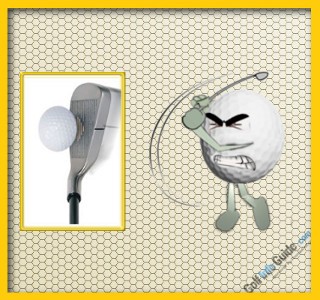
Jump
When it comes to golf, the term “jump” refers to the distance a golf ball travels in the air after impact. A jump shot occurs when the ball bounces high off the ground immediately after hitting the clubface, leading to a significant increase in distance. The jump can happen with any shot, but it is often associated with shots hit thin or off-center.
Causes of Jump Shots
There are several causes that can lead to a jump shot in golf:
- Thin contact: When a golfer strikes the ball with the lower part of the clubface, the shot becomes thin. This results in the ball jumping higher in the air due to the lack of solid contact. Golfers often experience this when they try to hit the ball too hard or when they have poor alignment.
- Off-center hits: Shots that hit the clubface away from the sweet spot, known as off-center hits, can also cause a jump. The misalignment affects the transfer of energy between the club and the ball, leading to an erratic flight path and increased altitude.
- Firm ground: Sometimes, golfers encounter firm ground conditions, such as hard fairways or dry soil due to weather conditions. When the ball strikes this kind of surface, it may bounce higher than usual, resulting in a jump shot.
Effects of Jump Shots
Jump shots can have both positive and negative effects on a golfer's game:
- Increased distance: One of the advantages of a jump shot is the additional distance it can produce. When the ball jumps higher, it spends more time in the air, allowing it to travel farther down the fairway. This can be beneficial when a golfer needs to clear an obstacle or reach a longer distance.
- Inaccurate trajectory: The increased height of a jump shot can also lead to a less predictable trajectory. The ball may have a steeper descent, making it more challenging to control the distance and accuracy of the shot. This can result in missing the intended target or finding an unfavorable lie.
- Limited spin: Jump shots often have reduced spin due to the lack of solid contact. This can affect the ball's ability to hold the green on approach shots, leading to longer putts and potential scoring challenges.
How to Minimize Jump Shots
To minimize the occurrence of jump shots and improve overall shot consistency, golfers can take the following steps:
- Proper setup: Ensure a correct setup by maintaining the correct distance from the ball, aligning the clubface square to the target, and positioning the body in a balanced stance.
- Centered contact: Focus on hitting the ball with the sweet spot of the clubface, aiming for solid contact. This can be achieved by maintaining a smooth, controlled swing and practicing good ball position relative to the feet.
- Choose the right club: Analyze the conditions and select the appropriate club for the shot. Consider factors such as wind, ground firmness, and target distance to make an informed decision.
- Golf ball selection: Some golf balls are designed to minimize jump shots. Experiment with different ball types to find the one that complements your swing and minimizes the unwanted jump effect.
Understanding and managing jump shots can positively impact a golfer's overall game. By working on consistency and technique, golfers can minimize the occurrence of jump shots and achieve better control and accuracy on the course.





